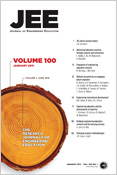Back
Back
Back
Back
Back

What began in 1910 as a magazine “devoted to technical education” disseminated by the Society for the Promotion of Engineering Education has become today the Journal of Engineering Education, a premier discipline-based education research journal published by the American Society for Engineering Education in partnership with a global network of engineering education organizations (ASEE, 1910; Prism, 2010). Its evolution reflects both the emergence of global communities of scholars and practitioners dedicated to education research in engineering and its commitment to providing a world-class publication that will help cultivate, disseminate, and archive their scholarship.
The Journal of Engineering Education launched its first five-year strategic plan in 2005 (JEE Strategic Plan, 2005). This plan served as a roadmap to reach higher levels of performance and achievement (Lohmann, 2010). For example—
While we are pleased with the journal’s growth, there is still much to be done to solidify our gains and accelerate our progress. This strategic plan charts our course.
As the Journal of Engineering Education begins its second century of service, we reaffirm its role, update its vision, and sharpen its mission. Our role describes who we are and how we fit within the education community, our vision presents our aspirations and hopes for this strategic plan, and our mission defines what we do to fulfill our role and achieve our vision.
The journal enjoys several strategic advantages, but it also faces some important challenges.
Recognition and Impact: The journal is recognized as the premier journal for engineering education research by many in the engineering and education communities spanning multiple disciplines and educational levels. It enjoys an early-entry advantage in the growing global market for education research in engineering and it has made significant progress bridging to the learning sciences and other education-related fields. However, it would benefit both from broader recognition among more scholars and practitioners in all these communities, and from greater recognition that its articles help shape engineering education policy and practice.
Global Engagement and Community Support: The journal has made substantial gains in global readership and authorship, and it has developed a new model for geographic breadth through a global network of partners. It is also well-connected to the global communities of engineering education researchers and a few other communities of education researchers. However, it could benefit from additional global readers and authors and greater engagement by its society partners and with the global learning science communities. It could also benefit from by making its articles more accessible to non-English readers, and from policies and practices that more fully recognize diverse education research approaches and global academic cultures.
Staffing and Access: The journal is supported by geographically and disciplinarily diverse partner societies, advisory board members, editors, and reviewers, as well as the elected leadership and staff of the American Society for Engineering Education. The print journal is widely read and highly cited. Nonetheless, the journal would benefit from additional marketing and global distribution, especially to institutional libraries and research databases and from more fully leveraging the power of information technologies.
Aspirations and Growth: The emerging field of scholarship in engineering education is topically, methodologically, and geographically diverse and provides many opportunities for contributions by the journal. However, the journal must be mindful that it cannot be “all things to all people.” Further, while visibility of engineering education research has improved considerably, it still remains far from being accepted as an important field of inquiry within the global engineering academic culture. Finally, even though the journal has been financially viable and fortunate to have the steadfast support from many individuals and organizations, it needs to raise resources if it is to achieve its strategic plan.
Goal 1: The Journal of Engineering Education will cultivate, disseminate, and archive a body of knowledge of scholarly research that leads to timely and significant improvements in engineering education worldwide by:
Goal 2: The Journal of Engineering Education will catalyze collaborations among global education research and related communities, discipline-based education research communities, and engineering education communities by:
American Society for Engineering Education (ASEE). (1910). Bulletin of the Society for the Promotion of Engineering Education, Vol. XVIII, No. 1. Ithaca, NY: Society for the Promotion of Engineering Education.
JEE Strategic Plan, 2005-2010, Advancing engineering education research worldwide. (2005). Journal of Engineering Education, 94(3): 283-284.
Lohmann, J. R. (2010). JEE strategic plan, 2005-2010: A summary report. Journal of Engineering Education, 99(4): 279-283.
Prism. (September 2010). JEE takes top spots, p. 74.
Lisa Benson
Editor, Journal of Engineering Education
Professor, Engineering and Science Education
Clemson University
M12 Holtzendorff Hall, Clemson, SC 29634-0956
864-656-0417 | lbenson@clemson.edu